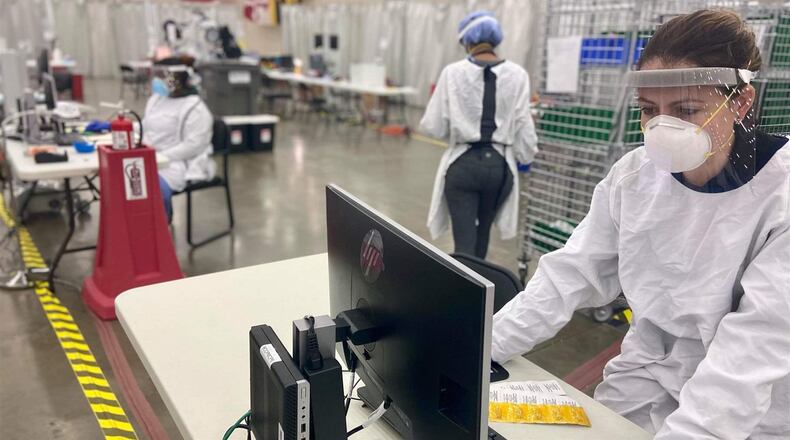PART 1
ABOUT THIS SERIES: Over the next two days, through our partnership with the Solutions Journalism Network, we’ll examine how the city of Baltimore faced COVID-19 – and ended up faring better than expected. As part of our solutions-oriented focus, we’ll share what lessons other cities might learn from Baltimore’s approach.
TOMORROW: While Baltimore did many things right, it was also much more cautious about reopening businesses and schools and relaxing mask requirements.
BALTIMORE — Dr. Letitia Dzirasa was less than a year into her new job as Baltimore’s health commissioner in February 2020 when she spoke publicly for the first time of a deadly new virus that was metastasizing on the other side of the globe.
Shortly after the news conference, Dzirasa and her husband took a weeklong vacation in the Caribbean. By the time she returned to Baltimore, her top priorities, including the twin epidemics of violence and opioid addiction ravaging the city, were upended by COVID-19.
“I did a press conference on Feb. 5 that probably no one paid attention to,” she recalled. “I remember coming back on Presidents’ Day and it was like, ‘Whoa!’ Between that third and fourth week in February, it became more obvious that this was going to be a big deal.”
She didn’t say it at the time, but she feared Baltimore was likely to be struck savagely by the virus.
Baltimore, after all, is a majority Black city in a country with wide racial health disparities.
Credit: contributed
Credit: contributed
It has a high poverty rate, a large population of immigrants with low incomes and densely populated neighborhoods full of thousands of workers without a work-from-home option.
On top of all that, Baltimore, like many U.S. cities and counties, has an underfunded public health system — with only about a third of the resources it needs, according to Dzirasa.
But a strange thing happened on the way to catastrophe.
Baltimore hasn’t escaped COVID-19, recording nearly 1,200 deaths from the virus. But compared with similar areas, it has fared far better than expected.
That is the conclusion of a September report from the Johns Hopkins Bloomberg School of Public Health, which compares Baltimore’s COVID-19 experience with 325 communities with similar demographic characteristics, including race and ethnicity, employment and health insurance status.
Baltimore fared better than the majority of its peers, landing in the upper percentile in several measures of the virus’s impact. The city ranked in the 81st percentile for the lowest incidence of cases, the 73rd percentile for the lowest cumulative mortality rate, and the 97th percentile for highest vaccination coverage.
“If you told the story beforehand, you would have said COVID is coming for Baltimore,” said Dr. Joshua Sharfstein, who was Baltimore’s health commissioner in the 2000s and is now a vice dean at the Bloomberg School of Public Health.
Dr. Peter Beilenson, another former Baltimore health commissioner who later filled the same post in Sacramento, Calif., described Baltimore’s performance as “startling.”
“The racial inequality, the poverty in Baltimore – that the number of cases and deaths were so low, that’s really impressive,” Beilenson said.
The most important factor in Baltimore’s success, public health experts said, has been strong leadership from city officials and support from a state government – split between a Republican governor and a Democratic legislature – that adhered to data and science rather than politicizing closures, masks and vaccines.
It certainly helped that Maryland is among the states with the lowest rate of residents without health insurance. Maryland also has embraced the Affordable Care Act, including Medicaid expansion, and runs a highly regarded state insurance exchange.
“People having health care coverage is a reason we’re doing so well with COVID,” said Vinny DeMarco, president of the Maryland Health Care for All Coalition, a well-known figure in Baltimore who has advocated for health care access in Baltimore and Maryland for decades.
But DeMarco and many others praised the city’s leaders, and especially Dzirasa, for steady and resourceful leadership during the crisis.
They said the city’s response has been characterized by fealty to data, targeted communication – and a willingness to tap outside help and expertise.
Throughout the pandemic, Dzirasa said, she has focused on “the impact it could have on those who were already marginalized.”
Those who worked on Baltimore’s pandemic response think other places can learn from the city’s community-wide response to COVID-19.
“This hasn’t been something we would have chosen,” said Dr. Charles Callahan, a vice president for population health at the University of Maryland Medical Center, one of the major players in Baltimore’s pandemic response. “But we can absolutely benefit from it.”
Michael Ollove writes for Stateline, an initiative of The Pew Charitable Trusts. This story is republished through the Solutions Journalism Network.
About the Author
Keep Reading
The Latest
Featured



